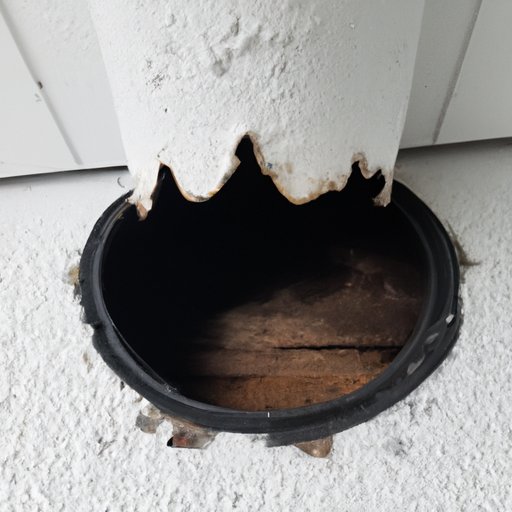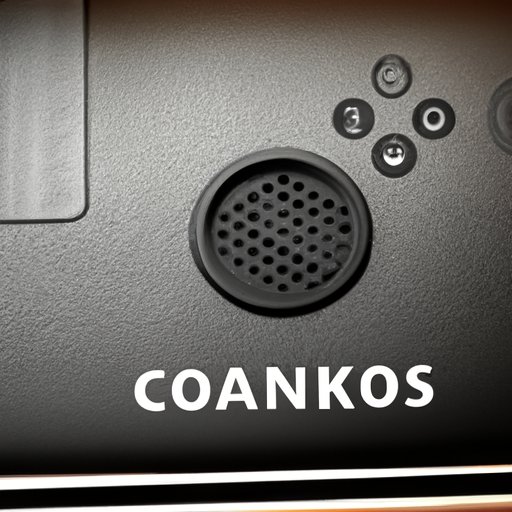Introduction
Carbon monoxide (CO) is an odorless, colorless, and highly poisonous gas that can be fatal if inhaled for too long. Its presence in the home can cause a range of health problems, from headaches and dizziness to nausea and even death. It is important to understand how carbon monoxide enters the home so that you can take steps to prevent it from happening. In this article, we will explore the various ways carbon monoxide can enter a home and what steps you can take to reduce the risk of exposure.

Definition and Overview of Carbon Monoxide
According to the Centers for Disease Control and Prevention (CDC), carbon monoxide is “a product of combustion of fuels such as natural gas, propane, fuel oil, kerosene, coal, or wood.” It is produced by burning these fuels in any type of equipment, appliance, or vehicle. Carbon monoxide poisoning occurs when too much of the gas builds up in an enclosed space. The symptoms of carbon monoxide poisoning can include headache, dizziness, nausea, confusion, chest pain, and even death. It is important to be aware of the potential health risks associated with carbon monoxide poisoning.

Leaky Furnace Flue or Chimney
One of the most common ways for carbon monoxide to enter a home is through a leaky furnace flue or chimney. If the flue or chimney is not properly sealed, then carbon monoxide can escape and enter the home. To identify a leaky furnace flue or chimney, look for signs of corrosion or rusting. Additionally, if the furnace is running but there is no hot air coming out, this could be an indication of a leak.
How to Prevent Carbon Monoxide from Entering Your Home:
The best way to prevent carbon monoxide from entering your home is to have your furnace and chimney inspected annually by a certified technician. They will be able to detect any potential leaks or other issues and make necessary repairs. Additionally, you should install carbon monoxide detectors throughout your home to alert you if levels become too high.
Faulty Gas Appliances
Another way for carbon monoxide to get into your home is through faulty gas appliances. If the appliance is not properly vented or if it is not maintained regularly, it can release carbon monoxide. To identify a faulty gas appliance, look for signs of rust or corrosion around the appliance. Additionally, if the appliance is producing a yellow flame instead of a blue one, this could be an indication of a problem.
How to Prevent Carbon Monoxide from Entering Your Home:
To prevent carbon monoxide from entering your home due to faulty gas appliances, have them inspected and serviced regularly by a qualified technician. Additionally, make sure all gas appliances are properly ventilated and do not block the vents. Finally, install carbon monoxide detectors throughout your home to alert you if levels become too high.
Wood-Burning Stoves and Fireplaces
Wood-burning stoves and fireplaces can also be sources of carbon monoxide. If they are not properly installed and maintained, they can emit carbon monoxide into the home. To identify a problem with a wood-burning stove or fireplace, look for signs of smoke or soot around the area. Additionally, if the fire is not burning evenly, this could be an indication of a problem.
How to Prevent Carbon Monoxide from Entering Your Home:
To prevent carbon monoxide from entering your home due to wood-burning stoves and fireplaces, have them inspected and serviced annually by a qualified technician. Additionally, make sure the chimney is clean and free of debris. Finally, install carbon monoxide detectors throughout your home to alert you if levels become too high.
Automobile Exhaust from Attached Garages
If your home has an attached garage, then it is important to be aware of the potential for carbon monoxide to enter the home through automobile exhaust. To identify automobile exhaust from attached garages, look for visible signs of exhaust fumes. Additionally, if you smell gasoline or car exhaust in your home, this could be an indication of a problem.
How to Prevent Carbon Monoxide from Entering Your Home:
To prevent carbon monoxide from entering your home due to automobile exhaust, make sure your garage door is well-sealed and always keep it closed when the car is running. Additionally, make sure any exhaust fans in the garage are working properly. Finally, install carbon monoxide detectors throughout your home to alert you if levels become too high.
Burning Charcoal or Gasoline
Burning charcoal or gasoline can also be sources of carbon monoxide. To identify burning charcoal or gasoline, look for signs of smoke or soot around the area. Additionally, if you smell gasoline or charcoal in your home, this could be an indication of a problem.
How to Prevent Carbon Monoxide from Entering Your Home:
To prevent carbon monoxide from entering your home due to burning charcoal or gasoline, make sure you are using them in a well-ventilated area. Additionally, never use a charcoal grill indoors or near an open window. Finally, install carbon monoxide detectors throughout your home to alert you if levels become too high.
Conclusion
Carbon monoxide is an odorless and colorless gas that can be dangerous when present in the home. In this article, we explored the various ways carbon monoxide can enter a home and what steps you can take to reduce the risk of exposure. These steps include having your furnace and chimney inspected annually, having gas appliances serviced regularly, making sure wood-burning stoves and fireplaces are properly installed and maintained, keeping your garage door closed when the car is running, and never using a charcoal grill indoors or near an open window. Additionally, it is important to install carbon monoxide detectors throughout your home to alert you if levels become too high.
(Note: Is this article not meeting your expectations? Do you have knowledge or insights to share? Unlock new opportunities and expand your reach by joining our authors team. Click Registration to join us and share your expertise with our readers.)
